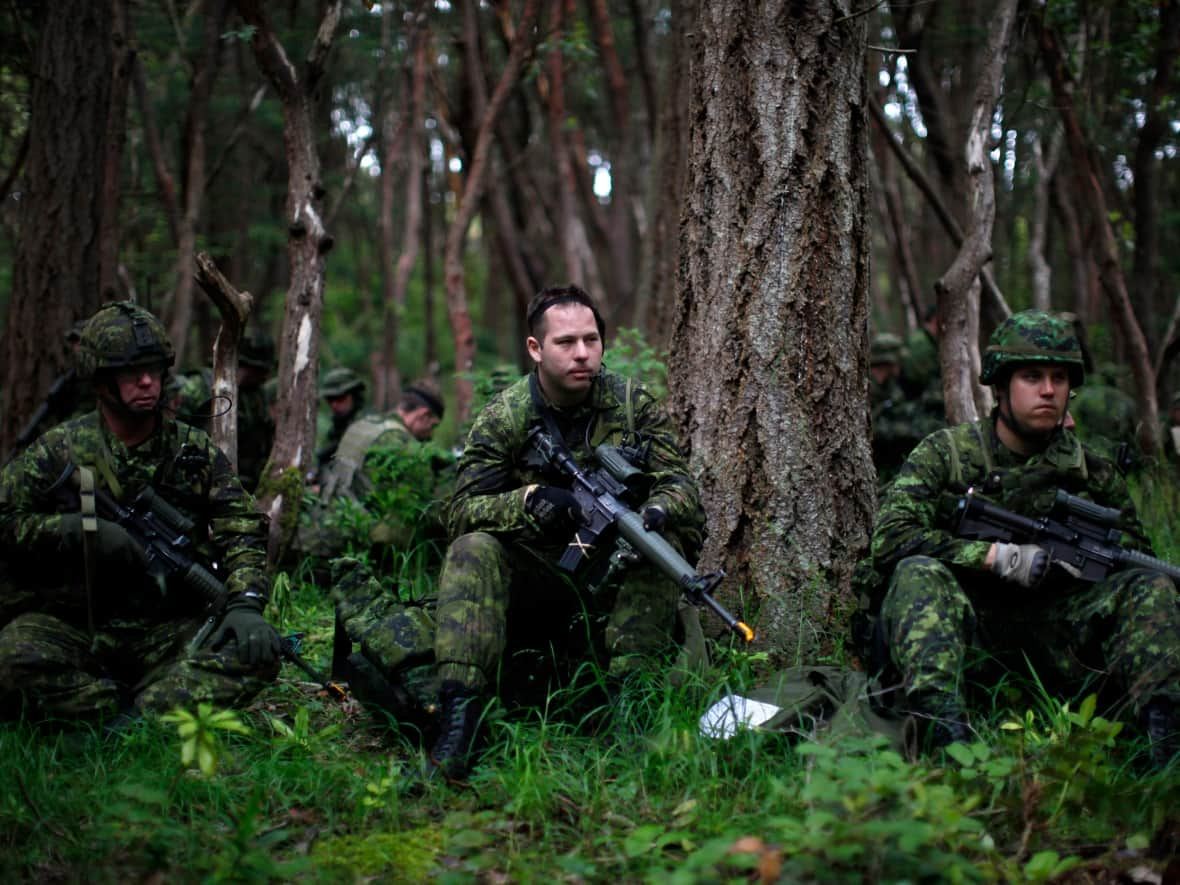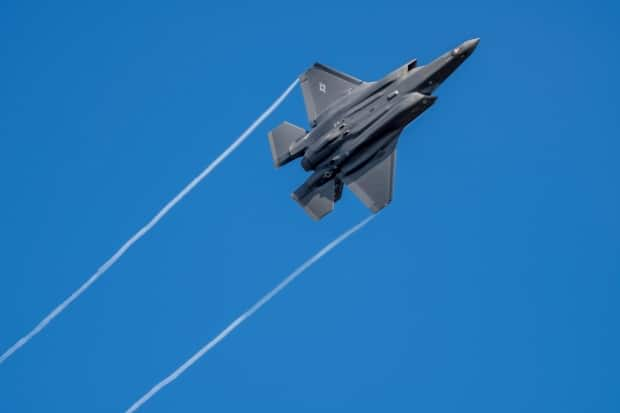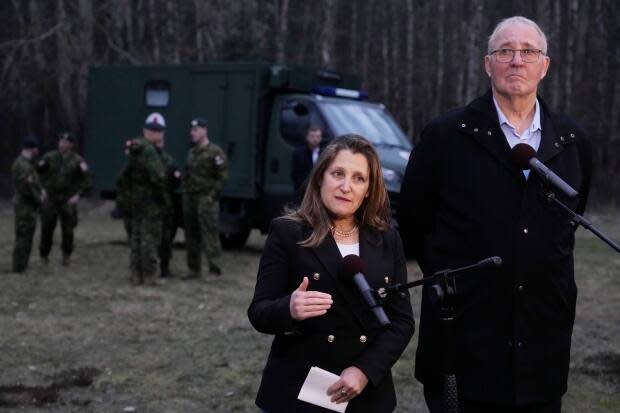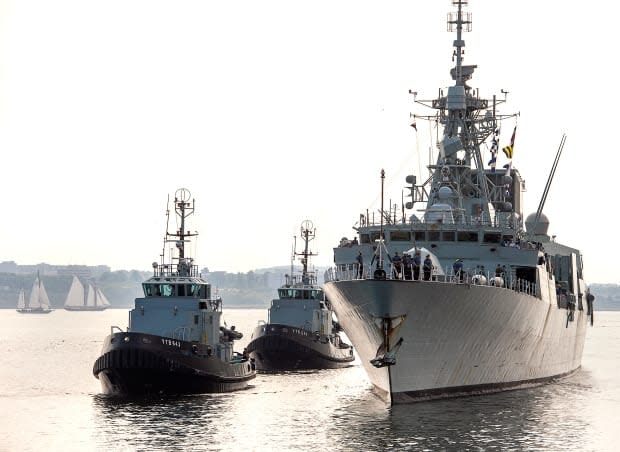Top soldier says military looking for 'clarity' on Ottawa's budget plans

- Oops!Something went wrong.Please try again later.
Just over a month into the new fiscal year and two weeks after the federal budget, the Department of National Defence is struggling to reconcile the Liberal government's approach to military funding — giving with one hand while taking with the other.
Gen. Wayne Eyre, the country's top military commander, told the rank-and-file in a remote town hall event last week that he doesn't have answers to crucial questions about how internal budget cuts and funding reallocation square with promises of additional money in the recently released defence policy.
"We're being asked to suck and blow at the same time," Eyre, the chief of the defence staff, told about 1,300 members of the Armed Forces who tuned in for the presentation. A video copy of his presentation was obtained by CBC News.
"We got some budget cuts last year," he added, referring to the wave of spending reductions announced by Treasury Board President Anita Anand last fall. "We're getting new funding this year. Reconciling the two of those is a bit of a challenge. The finance staff is working on that right now."
WATCH: Gen. Eyre says he doesn't have 'clarity' on budget's impacts on military
Eyre, who is expected to retire this year, told the audience that he's hoping to get a better idea of how the internal cuts announced in late 2023 will affect operations and maintenance.
"We have more funding in the future, as you know," Eyre said in a response to a question from the audience. "This year on the operations and maintenance side, we are facing some challenges. And you talk about confusion — I don't have complete clarity yet either, as the finance staff continue to analyze the impacts of this year's federal budget."
Eyre also hinted the federal government is weighing calls to eliminate some military capabilities that the different services — army, navy, air force — have said they can do without. He said he's asked the commanders of the various branches to come up with "tangible examples of those capabilities that we should put on the chopping block" and has received a few recommendations.
'Tangible' cuts coming, says Eyre
"You will probably see some — I'm not going to get ahead of some ministerial decisions here — but we are going to have to cut a few tangible ones based on advice that's come up from the services," he said.
The internal cuts and budget juggling come as the military faces a readiness crisis. Critics warn that it would have a hard time responding to calls for help from NATO in the event that international tensions escalate.
The new defence policy promises to invest an additional $8.1 billion in the military in the near-term and over $73 billion over the next two decades — but much of that funding is earmarked for future years. The Opposition Conservatives call the policy "aspirational."

The federal budget anticipates a slight increase in overall defence spending this year and projects a 30 per cent increase in the next fiscal year — when the government is expected to start paying for big-ticket items of replacement equipment, including the new F-35 fighters.
Appearing before the House of Commons defence committee last fall, Defence Minister Bill Blair attempted to assure MPs that the planned internal cuts will be surgical.
'The instructions we've received from Treasury Board, and that I passed on to both the [chief of the defence staff] and the deputy minister, are that we are looking at ways in which we can eliminate unnecessary costs, but none of those reductions are to impact the capability of the Canadian Armed Forces or the supports that we provide to the men and women of the Canadian Armed Forces," Blair testified on Nov. 23, 2023.
On Wednesday, while promoting the federal budget and the defence policy before a think-tank audience in Ottawa, Blair said pressing the federal cabinet for higher defence spending overall has been an uphill battle.

"I had to sort of keep on pushing my issue forward, about the importance and the need to invest in defence," Blair told the audience at Canadian Global Affairs Institute symposium.
He added that he's struggled to make the case for Canada spending 2 per cent of its gross domestic product on defence — a spending benchmark agreed to by all NATO members.
"Trying to go to cabinet, or even to Canadians, and tell them that we had to do this because we had to meet this magical threshold at two per cent for the NATO commitment — don't get me wrong, it's important," he said. "But it was really hard to convince people that that was a worthy goal, that it was some noble standard that we had to meet, because nobody knows what that means."
The defence policy projects the current plan would move the needle on the country's investment in defence from 1.33 per cent of GDP to 1.76 per cent. Blair is on the record saying that in order to meet NATO's two per cent target, Ottawa would need to invest an additional $6 billion to $7 billion annually on top of what's already been promised.
"So it's really for me, I couldn't go and make a defence policy argument to reach that spreadsheet target of two per cent," Blair said Wednesday.
Eyre said the debate over NATO metrics doesn't concern him.
"I don't care about percentage of GDP in terms of spending," Eyre told the town hall. "For me, that's an input metric. What I care about is, what does the armed forces and the [defence] department produce as an output metric, which is capabilities and readiness?"
Eyre also critiqued the new defence plan in blunt terms.
"This policy was not as fast as we wanted it to be, and it did not give us everything that we needed, but I will tell you, it's more than I expected — much more than I expected — going into it," Eyre said.
"Would we have wished for a more rapid implementation? Well, yes. But we've got our marching orders and it's time to move out and within our own realm, within our own arcs of influence, implement as quickly as possible."
The federal budget does earmark significant funds, starting this year, for maintaining older fleets, including the navy's three-decade-old frigates.

It sets aside $1.9 billion to keep the frigate fleet afloat over the next five years and to extend the lease on the navy's privately contracted supply ship.
But the defence department is still expected to find $810 million in savings in the current budget year, as part of the Liberal government's overall austerity drive. The federal budget estimates say that, going forward, DND is expected to find $851 million in savings in the 2025-26 budget year and $907 million thereafter.
That's money the department had been expecting but will now have to do without.
The last time the defence department went through a major budget-cutting exercise was more than a decade ago, under the former Conservative government.
One of the areas hit hardest back then was the internal budget category known as national procurement funding — the cash that covers equipment maintenance, repair and overhaul, and in-service support.
The cuts between 2012 and 2014 led the army to park a large number of its vehicles, the air force to reduce flying hours by a quarter and the navy to tie up some of its warships.
Anecdotally, some in the army trace the current shortage of spare parts — which today is severely limiting the use of Leopard 2 tanks — back to the budget restraint of a decade ago.
Responding to the current round of budget cuts, the defence department acknowledged in a recent media statement that the national procurement pot of money will be affected this year, but insisted there will be money for military priorities.
"Due to the importance of National Procurement funding for the sustainment of CAF fleets and their materiel readiness, the Department is not intending to reallocate any significant amount of National Procurement funding," said the statement.
Operations and maintenance may go under the knife
The department was asked to explain what it means by "significant." It did not. "Decisions on savings are ongoing," DND said in a statement issued to CBC News. "Government of Canada priorities for defence will continue to guide our work across the organization."
When the Conservatives were cutting the defence budget, the separate pot of money for operations and maintenance (O&M) took a heavy hit.
Since November, anecdotal reports out of the defence department have suggested that operations and maintenance funding for reserve units was being slashed, in some cases by as much as 30 per cent.
The department told CBC News that individual units will have to decide how cuts to travel and professional services will affect their operations budgets.
"It is too soon to say how this could affect reserve units' O&M funding," the statement said.

